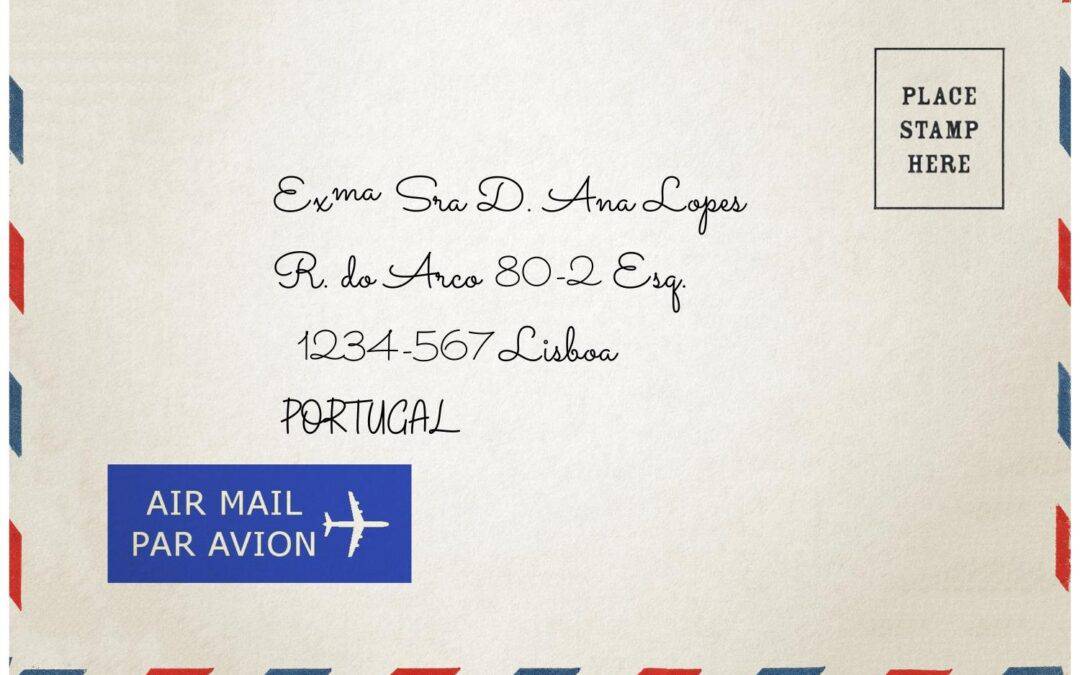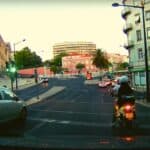Understanding addresses in Portugal takes some know-how, but it’s not as hard as it might look. You only need to memorise a few Portuguese postal conventions to be able to address correspondence properly and to get around with confidence. So, hold tight as we guide you through the conventions of Portuguese street addresses.
Postal addresses in Portugal follow a common pattern:
| Recipient name | Ana Lopes |
| Street-type abbreviation + street name | R. do Arco |
| Street door number + floor number + door identifier | 80-2 Esq |
| Postcode + locality | 1234-567 Lisboa |
Portugal mail addresses have a min. of 3 lines, eg:
Ana Lopes
R. do Arco 80-2 Esq.
1234-567 Lisboa
You’ll never get lost in Portugal again if you remember just a handful of facts essential to following Portuguese directions. We’ve prepared 8 easy-to-memorise snippets that make sure you can decipher Portugal’s street addresses and always arrive at your destination with minimum stress.
We’ll also cover the basics of Portugal’s postcodes by regions to help you with your correspondence.

Portugal postal address topics this article will cover:
- Portuguese street types and their abbreviations
- Portuguese door number and floor-level conventions and abbreviations
- Portugal apartment door identifier conventions
- Portuguese street names and some common spellings and abbreviations
- Portugal’s postcodes by region
- Portuguese name titles and what they mean
Apart from the above topics, we’ll also cover some essential navigation tips for Lisbon. Portugal’s capital and largest city is where getting around can be a bit tricky if you don’t know the lay of the land. But our tips can also be applied to the rest of Portugal.
1. Portuguese street types and their abbreviations
Portugal’s more common street types and their abbreviation – such as Rua (R. – street), Avenida (Av. – avenue) or Praça (Pç – square) – might be easy enough to understand. But then there are dozens more Portuguese thoroughfare types that can be confusing if you’re not familiar with their abbreviations or how they are pronounced.
The first thing to note about Portuguese postal addresses is that the street type appears before the street name. This will be different to what you are used to if you come from an English-speaking country.
Keep in mind #1: In Portugal the street type abbreviation is placed before the street’s name. Where in English you’d write “10 Downing St.”, in Portuguese you’d write “R. de Downing 10”.
\
Portugal’s most common street types:
| Street type – Abbreviation | English equivalent | Pronunciation |
| Rua – R. | street or road | rooh-uh |
| Avenida – Av. | avenue | av-needuh |
| Praca – Pc / Pç / Pça | city square or plaza | prah-suh |
| Travessa – Tv | narrow and/or secondary street | truh-veh-suh |
| Largo – L / Lg / Lgo | like Praça | lhar-guo |
| Beco – Bc | alley | beh-cuo |
| Calçada – Cc / Cç | paved thoroughfare | cal-sah-duh |
Portugal’s less common street types/location types:
| Street type – Abbreviation | English equivalent | Pronunciation |
| Alameda – Al | boulevard | ala-meh-duh |
| Calcadinha – Ccnh | paved thoroughfare | calsuh-dee-nuh |
| Campo | field or plaza | Can-puo |
| Escada – Esc | stepped pedestrian street | escah-duh |
| Escadinhas – Escnh | as above but secondary | escah-dee-nuhs |
| Estrada – Est / Estr | road | estrah-duh |
| Estrada Nacional – EN | national road | estrah-duh nassee-uonahl |
| Jardim – Jrd | public park | jar-deen |
| Larguinho – Larg | small plaza | lur-gheenhuo |
| Loteamento – Lote | allotment | loteea-mentuo |
| Parque – Pq | park | pahrk |
| Pátio – Pto | yard | pah-tio |
| Praceta – Pct | small plaza | pruh-ssehta |
| Rodovia – Rvia | vehicle road | rohdo-veeuh |
| Rotunda – Rot | roundabout | roh-toonduh |
2. Portuguese door number and floor-level conventions and abbreviations
Now that we’ve covered the many types of Portuguese streets and location descriptors, let’s get on to the door number and floor-level conventions.
In Portugal’s postal addresses the street door number appears after the street type and name. For example, Ana Lopes lives in street door number 80 in Rua do Arco. Her street address begins like this
R. do Arco 80
Ana lives on the second floor. We need to add 2 after a dash to indicate her second-floor level apartment.
R. do Arco 80-2
On Ana’s floor level there are 2 apartments – hers and her neighbour’s. One apartment door is on the left as you step on her landing (from the stairs or elevator), the other is on the right.
Ana’s apartment door is on the left, so we need to add the left-side identifier abbreviation to the address. “Esquerdo” is Portuguese for left side – the most common abbreviation of “esquerdo” is Esq.
Esq is the last thing we need to add to this line of Ana’s address.
R. do Arco 80-2 Esq
More on floor-level conventions in Portugal addresses
Floor levels appear after the street door number, usually after a dash.
In Ana Lopes’ address case the 2 is the numeric representation of second-floor, or “segundo andar” in Portuguese. Other ways “segundo” can look are 2o and 2o, where the “o” is the last letter of the word “segundo”. The same goes for “primeiro” (first), which can be represent as 1 or 1o or 1o.
Let’s look at the most common floor level conventions.
| Floor Level | Abbreviation |
| Cave (basement level) | Cve |
| Rés do Chão (ground level) | R/C |
| Primeiro (first level) | 1 or 1o or 1o |
| Segundo (second level) | 2 or 2o or 2o |
| Terceiro (third level) | 3 or 3o or 3o |
| Quarto (fourth level) | 4 or 4o or 4o |
| Quinto (fifth level) | 5 or 5o or 5o |
| Sexto (sixth level) | 6 or 6o or 6o |
| Setimo (seventh level) | 7 or 7o or 7o |
If Ana lived on the ground floor at the left, we’d need to replace 2 with “R/C”, like this:
R. do Arco 80-R/C Esq
That’s because in Portuguese R/C is the abbreviation for “rés do chão”, literally “ground floor.”
Keep in mind #2: R/C stands for ground floor in Portuguese. Floor levels appear after street door numbers. For example, 80-R/C.
3. Portugal’s apartment door identifier conventions
For residential as well as office buildings, after the street door number and the floor level comes the door identifier.
Ana’s neighbour has an apartment door on the same level – but on the right side as you step onto the landing. The neighbour’s address will be identical to Ana’s except that “Dto” replaces Ana’s “Esq”. Dto is the abbreviation for “direito”, which is the Portuguese word for “right-side”.
Ana’s next-door neighbour’s address:
R. do Arco 80-2 Dto
The majority of residential apartment buildings in Portugal only have 2 apartments per level. The convention used to identify apartment doors in these buildings is not a number or letter screwed to the door, like you might be used to.
Instead, you need to think in terms of right or left. As you step on the landing, you head to the left if the address says Esq (or Esqo or just E) – for “esquerdo”. Or you head to the right if it says Dto (or Dto or just D) – for “direito”.
Keep in mind #3: In Portugal, apartment doors are most often identified by their left or right-side in relation to the landing’s access. Not by door numbers or letters.
It’s also quite common for an apartment building to have 3 apartments per floor.
In that case, the 3 apartment doors on each level are once again identified by how they stand in relation to the landing’s access. There will be one apartment door on the right, one on the left and one door directly ahead.
This third frontal door is identified as “frente” – abbreviated to Ft or just F.
For apartment buildings with more than 3 apartments per floor, that’s when each door will be identified by a number or letter on the door.
Just to make things more confusing, many apartments in buildings that were built in Portugal up to the 1940s had two front doors. Not counting with the back door that led to a fire-escape stairs/services’ access.
This second front door was destined for access to the family’s lodger. Paying lodgers were practically a national institution in middle-class households in Portugal’s urban centers up until quite recently. These lodgers occupied one single bedroom, which also had an internal door access to the rest of the apartment.
The third frontal door you see in the image below is just one such lodger’s door. In the case of this 1930s Lisbon apartment building, only one side of the building – the right-side – held apartments with an extra bedroom for a lodger (and an extra door).
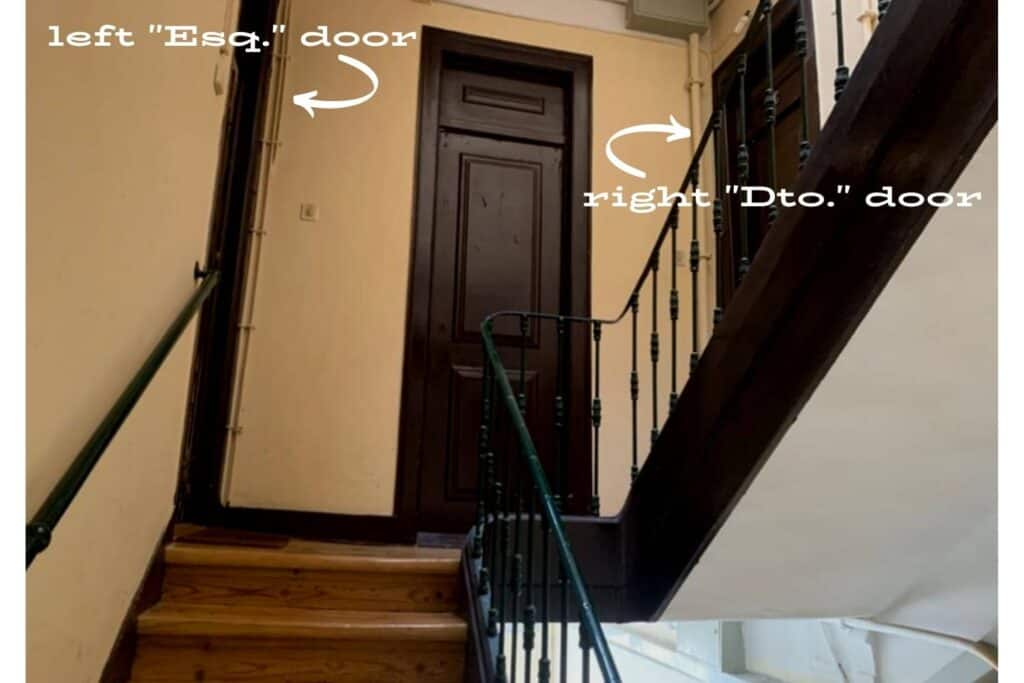
Most common door identifiers and their abbreviations
| Esquerdo (left side) | Esq or Esqo or E |
| Direito (right side) | Dto or Dto or D |
| Frente (frontal) | Fte or Fte or F |
Keep in mind #4: Only in Portuguese buildings that have more than 3 apartments per floor will these be identified by letters or numbers attached to the doors themselves.
Another thing to note is that the apartment side does NOT have to do with how it appears on the building’s façade.
In fact, an apartment whose door is identified as being on the left often appears on the right-side of the façade. In the image below, the apartment identified as on the left (Esq.) has its window appearing on the right of the façade.
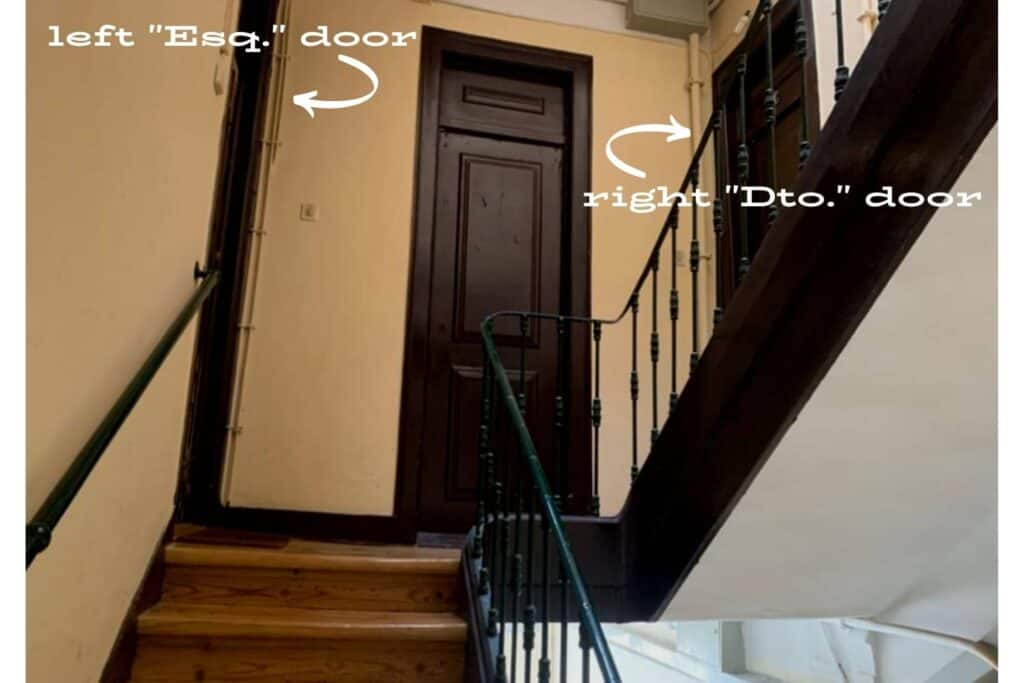
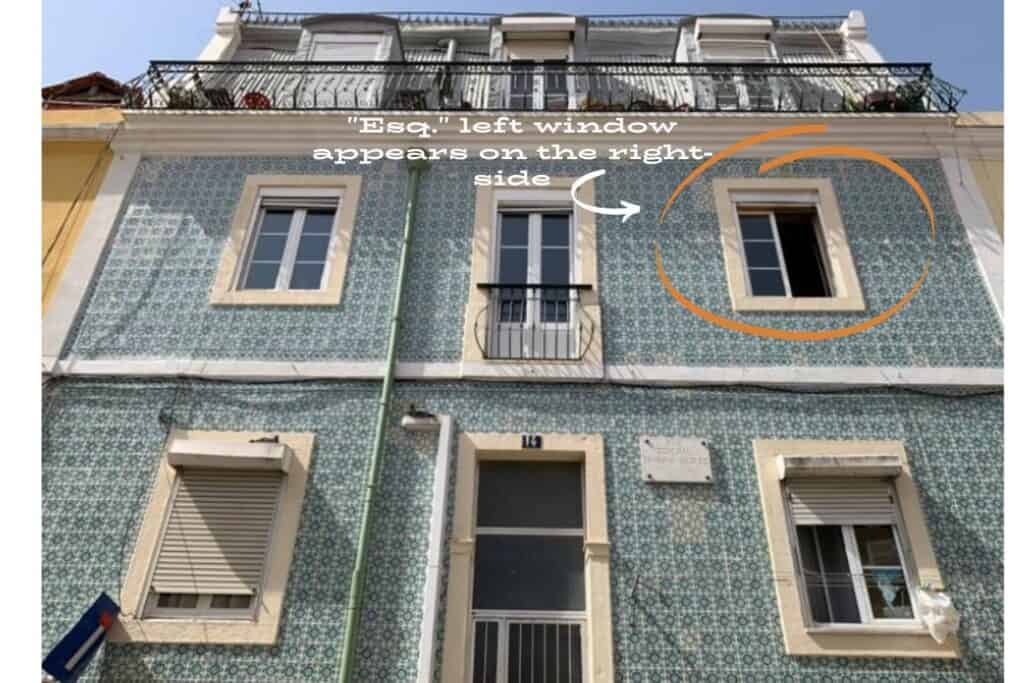
Keep in mind #5: If an apartment looks like it’s on the left when looked at from the street, that does NOT mean its door identifier is the left-side. Most often the opposite is true. Instead, think in terms of what side the door is as you step onto the landing (or off the elevator).
4. Portuguese street names and some common spellings and pronunciations
Portuguese streets are often named after notable people, saints or historic events.
Often these notable people had titles preceding their name that can look puzzling in Portuguese street names.
The most common titles such as Dr (male doctor or scholar) or Dra (female doctor or scholar) are not hard to figure out, even if you don’t speak Portuguese. But there are many other more ornate name titles that appear in street names.
Common name titles used in streets named after notable people:
| Title / Meaning in English | Abbreviation |
| Alferes – Ensign | Alf. |
| Almirante – Admiral | Alm. |
| Arquitecto – Architect | Arqto or Arqto |
| Brigadeiro – Brigadier | Brig |
| Capitão – Captain | Cap |
| Comandante – Commander | Cmdt |
| Comendador – Commentator | Comend |
| Conselheiro – Councillor | Cons. |
| Coronel – Colonel | Cor. |
| Dom – King | D. |
| Dona – Madam or Queen | D. |
| Doutor – Doctor | Dr |
| Doutora – Female doctor | Dra |
| Duque – Duke | Dq |
| Engenheiro – Engineer | Eng. |
| Frei – Friar | Fr |
| General – General | Gen. |
| Infante – Kings male son | Inf |
| Marquês – Marquis | Mq |
| Padre – Father | Pe |
| Presidente – President | Presid |
| Professor – Professor | Prof. |
| São – Saint (male) | S. |
| Santa – Saint (female) | Sta or Sta |
| Sargento – Sargent | Sarg |
| Tenente – Lieutenant | Ten |
| Visconde – Viscount | Visc |
You’ll notice that many streets and locations throughout Portugal are named after saints.
S. and Sta are common abbreviations that stand for male saint and female saint, respectively. These often make appearances in Portugal addresses.
- S. stands for São (title for male saint) and is pronounced suh-on.
- Sta stands for Santa (title for female saint) and is pronounced sun-ta.
Keep in mind #6: S. and Sta a very common abbreviation in Portuguese street names that stand for “Saint”. An example of a Lisbon street name with a saint’s name is Rua de S. Cristovão (Saint Christopher Street).
5. Portugal’s postcodes per region
Each Portugal postal address has its own postcode, or “código postal”. These postcodes have 7 digits in the xxxx-xxx formation. They appear in the bottom line of the postal address.
Let’s look at Ana Lopes’ address again.
Ana Lopes
R. do Arco 14-2 Esq.
1234-567 Lisboa
The above Lisbon postcode probably doesn’t exist, but it’s true that Lisbon’s postcodes start with the number 1.
In fact, you can tell the region of a Portugal address by the first number in the postcode.
Portugal has 9 postcode regions. Because of that, Portugal’s postcodes start with the numbers from 1 to 9.
List of Portugal postcode regions and their number identifier
1XXX-XXX – Greater Lisbon region
2XXX-XXX – Setúbal city, Leiria and Santarém regions
3XXX-XXX – Coimbra, Aveiro and Viseu regions
4XXX-XXX – Porto, Braga and Viana do Castelo regions
5XXX-XXX – Vila Real and Bragança regions
6XXX-XXX – Guarda and Castelo Branco
7XXX-XXX – Setúbal, Portalegre, Évora and Beja regions
8XXX-XXX – Algarve
9XXX-XXX – The islands of Portugal’s Azores archipelago and Madeira (not shown)
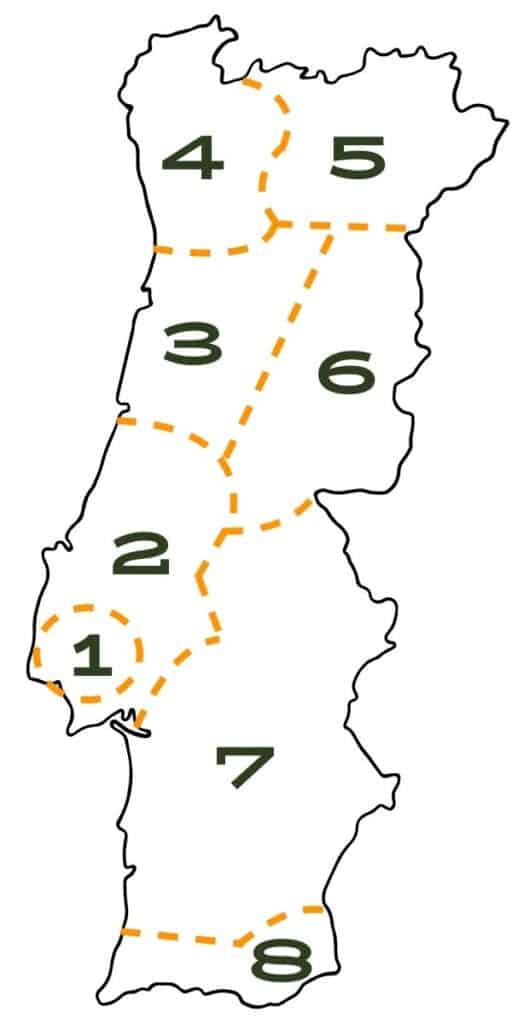
6. Portuguese name titles and what they mean
Now that we have the street names and address conventions covered – and before we move on to some essential navigation tips for Lisbon – let’s talk about Portuguese name titles.
Portuguese name titles are not limited to Mr or Mrs or Dr. Very often the recipient’s name, as it appears in correspondence – in the envelope or heading a letter – is preceded by a collection of abbreviations that must seem mysterious to the uninitiated.
For example, if Ana Lopes was my best friend I might address the envelope simply with her name: Ana Lopes.
But more often than not, and even if you’re addressing a letter to someone you know intimately, the recipient’s name is preceded by at least one name title or mode of address.
It’s more likely that the letters Ana Lopes receives are addressed using a title before her name. For example, Sra Ana Lopes.
Sra is the abbreviation for “senhora” (Mrs), and Sr is the abbreviation for “senhor” (Mr).
Below are the most likely Portuguese correspondence titles and modes of address used for an adult woman, from less formal to more formal:
- Sra Ana Lopes – Mrs Ana Lopes
- Sra D. Ana Lopes – Mrs Madam Ana Lopes
- Exma Sra D. Ana Lopes – Most Excellent Mrs Madam Ana Lopes
These titles probably sound absurd because they are not used in English. But it is true that Exma or Exma stands for “most excellent”. In Portugal this mode of address is still commonly used in correspondence to this day.
If Ana has a husband called Paulo Guedes, say, these are the most likely name titles in the letters he receives:
- Sr Paulo Guedes – Mr Paulo Guedes
- Exmo Sr Paulo Guedes – Most Excellent Mr Paulo Guedes
Portuguese modes of address become even more ornate if the recipient is a doctor or engineer – or just about any other profession with an attributable title.
For example, Ana Lopes might be a doctor or an architect or an engineer. These are the titles and modes of address she would likely see in correspondence addressed to her:
- Exma Sra Dra Ana Lopes – Most Excellent Madam Doctor Ana Lopes
- Exma Sra Arqta Ana Lopes – Most Excellent Madam Architect Ana Lopes
- Exma Sra Enga Ana Lopes – Most Excellent Madam Engineer Ana Lopes
And so on.
And if Ana’s husband is a doctor or architect or engineer, it will be the same string of titles and modes of address (except for the superscript “a”, which denotes the female gender of his wife’s titles).
Related: Read our article on Driving in Portugal After Brexit With a UK Licence: Your FAQs answered
Essential Lisbon navigation tips
Now that we covered the most essential things to know about Portuguese addresses – most excellent Portuguese postal addresses, if you please – let’s move on to some essential navigation advice.
We will focus on tips on how best to navigate Lisbon. But some of this advice will apply equally to other locations in Portugal.
Tip #1 Ask a local if you can’t find a door number before giving up all together
Don’t expect streets in Lisbon (or anywhere else in Portugal) to follow an uninterrupted line. Streets might turn a corner, duck under a passage or reappear on the other side of a building. Locals are usually more than happy to assist tourists or other less local locals.
Tip #2 Keep in mind that location names can have unofficial versions that are more commonly used
Some streets and locations in Lisbon have official versions that are the ones that appear in the postal address. However, these can be sometimes called differently by the locals.
List of notorious Lisbon examples where a place is known by two different names:
- Rossio in Lisbon is a downtown square that’s officially called Praça Dom Pedro IV, but everyone calls it Rossio;
- Praça do Comércio in Lisbon is another downtown square that also goes by the name of Terreiro do Paço;
- Campo dos Mártires da Pátria in Lisbon is also commonly called Campo Santana;
- Praça Duque da Terceira is a square in downtown Lisbon that is universally known as Cais do Sodré (which is also the name of the train station there);
- Largo Adelino Amaro da Costa, also in downtown Lisbon, is also called Largo do Caldas after its palace.
So, if someone gives you directions in Portugal and you can’t find it on the map, it might be because they used an unofficial name. Ask someone else before despairing – most Portuguese people enjoy the opportunity to help and give directions!
Keep in mind #7: Rossio is a downtown square in Lisbon that has a very different official name. Fortunately “Rossio” also appears in Google maps nowadays. It’s not uncommon for Portugal locations to be known by different names.
.
And talking of Rossio, the train station called “Rossio” (which is where you catch the train to wonderful Sintra) is closer to the Restauradores metro station than to the Rossio metro station. So, remember to get off at the Restauradores metro station if you are catching the train to Sintra.
Tip #3 Carry your address written in a piece of paper and learn to pronounce it
If you carry a piece of paper with your address that you can quickly show a taxi driver, this will save time and unnecessary confusion.
But it’s also a good idea to learn to pronounce your address. If a medical, police or fire emergency occurs and you need to ring the emergency number (112), the first thing you will be asked is your address.
If you are staying in Portugal even for just a few days and renting an Airbnb apartment or similar, ask your host to repeat the address out loud so you can tape it in your phone’s voice memo app.
Keep in mind #8: It’s a good idea to memorize and learn to pronounce your home address in case you need to ring Portugal’s emergency number 112. Often, you’ll also be asked your address when contacting Portugal’s authorities.
Happy letter writing and map navigation in Portugal!

